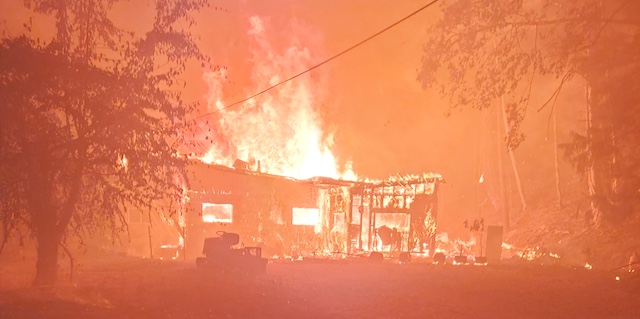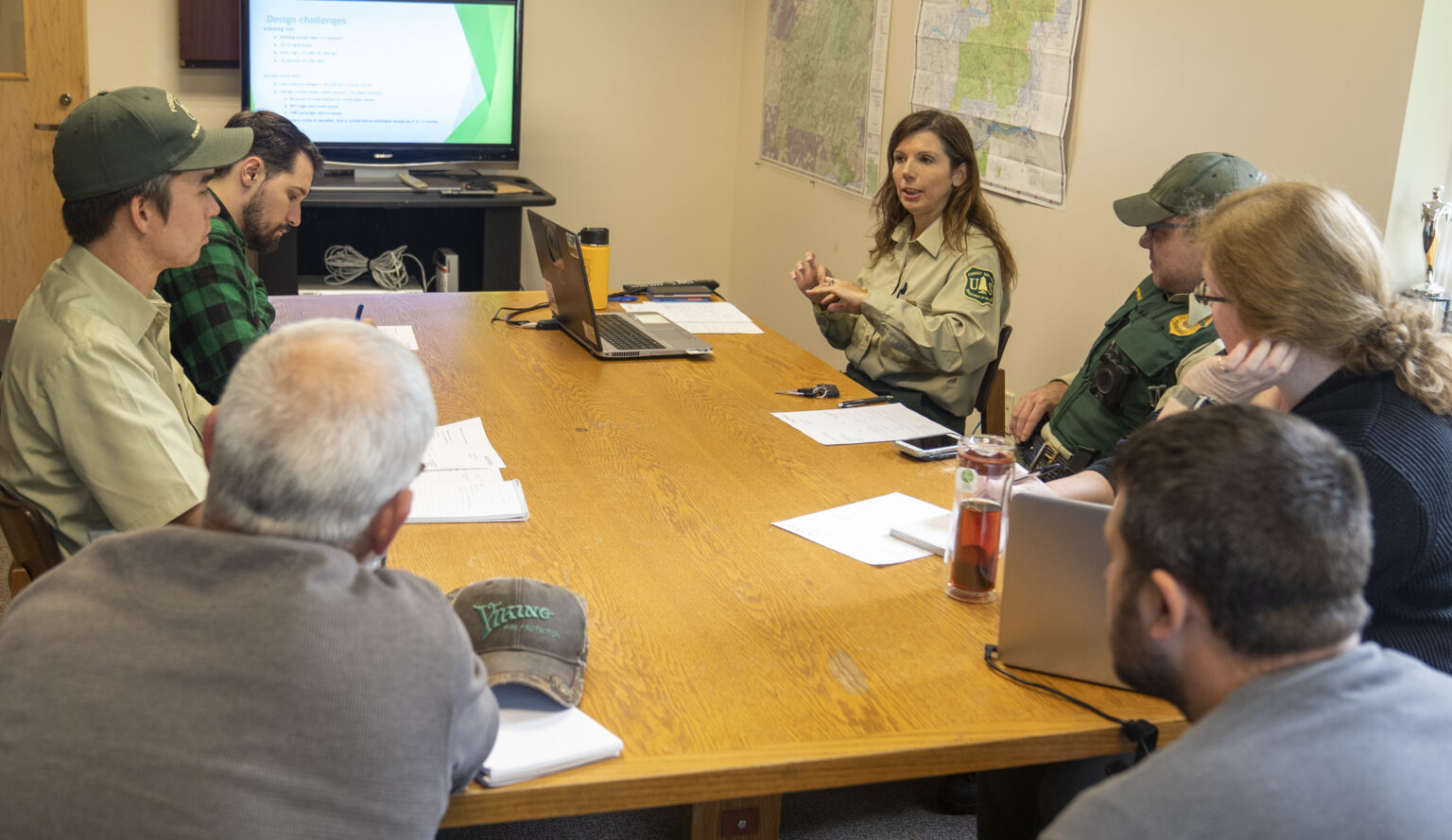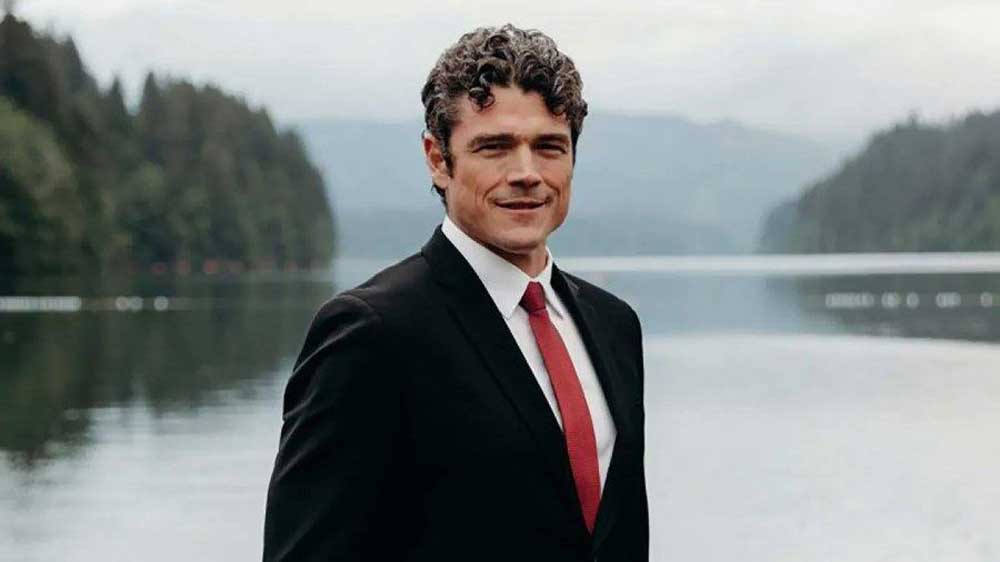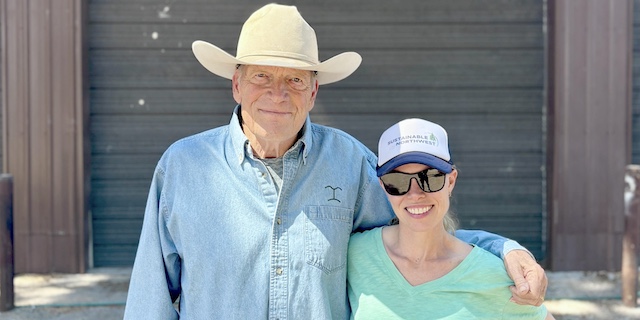Wildfire defense faces collective conundrum
Published 10:22 am Thursday, May 15, 2025

- A home in Gates, Ore., burns during the 2020 Labor Day fires. (Courtesy Bill Edge, Elemental: Reimagine Wildfire)
Preparing one’s home for wildfire doesn’t have to be expensive to be effective, but that won’t necessarily make it any more convenient.
For example, clearing a home’s vicinity of bulky “yard art” — dilapidated vehicles and other obstructive material — provides fire trucks with maximum mobility.
“They have to have the access. These guys need to be able to get in and have the room to maneuver,” said Miranda Stuart, a retired deputy chief of fire operations with the Bureau of Land Management. “It becomes a lot easier for us to attack.”
Trending
While this advice may seem like common sense, it’s also common to see the perimeter of rural homes adorned with such obstacles, or piles of ember-harboring mulch, or overhanging branches of flammable vegetation.
“Stop planting lavender and rosemary against your damn house,” Stuart said at a recent wildfire resilience class in Ruch, Ore., organized by Oregon State University.
Bark dust and mulch are also frequent culprits in making homes susceptible to wildfire, as they allow embers to fester for an extended period of time before eventually bursting into flame, she said.
“It can take two weeks for that stuff to go up,” Stuart said, noting that homes often burn down after the initial front of flames has passed. “Overall, mulch in concentration is a place for embers to land and become a problem.”
Of course, as public health officials have long known, telling people what’s good for them is quite another thing than persuading them to do it. It’s especially challenging to coordinate such defenses across entire communities.
With wildfire activity becoming more prevalent and destructive across the West, though, governments need to find ways to boost fire preparedness in the “wildland-urban interface,” where forests and rangelands are interspersed with human development, experts say.
Trending
Preparedness is a more realistic goal than prevention, as it’s virtually impossible to stop every lightning bolt or teenager with firecrackers from potentially wreaking havoc, said Ralph Bloemers, director of fire safe communities for the Green Oregon nonprofit.
“Fire is part of our DNA. It’s part of who we are. Being stupid is also sometime part of who we are,” Bloemers said.
But as Oregon lawmakers found out in recent years, trying to impose home-hardening and defensible-space requirements on rural landowners did not meet with much enthusiasm.
This year, the state’s Legislature is on track to overturn a controversial wildfire map approved under a 2021 bill, which enacted stricter regulations for houses deemed at high risk of wildfire.
Telling people what do with their property is bound to meet resistance in culturally conservative rural areas, which is part of the reason the approach didn’t work, said Sen. Jeff Golden, D-Medford, an early proponent of the wildfire map who’s also led the charge to abolish it.
“They choose to live rurally to have fewer rules they have to live by,” he said.
Another major reason the wildfire map proved unfeasible was that it was based entirely on “landscape-level factors,” which didn’t account for the fire-resilient measures that landowners have already taken, said Golden.
“It didn’t work to have no consideration of what’s going on with a particular property,” he said.
The problem is that homeowners who refuse to make defensive improvements can undermine the efforts of their more responsible neighbors, particularly where houses are clustered together.
“Those can become the dominoes that knock the rest of them down,” Bloemers said. “The community is only as prepared as it is collectively prepared. You need the community to be a force multiplier.”
Though the Oregon wildfire map was a “fairly coarse assessment” of “limited utility,” Bloemers worries that eliminating it could create the perception the state government is backsliding in its preparedness efforts.
A proposal to abolish the map and associated regulations, Senate Bill 83, has passed the Senate unanimously and is now being considered in the House.
“It sends the signal to the insurance industry that Oregon is not prepared to deal with the hazard,” he said.
Since tackling the problem with a statewide edict didn’t have the desired effect, lawmakers are now attempting to compel cooperation among neighbors through voluntary incentives and local government involvement.
Under Senate Bill 85, which is also making headway this year, Oregon agencies would consult with the insurance industry on spurring collective fire preparedness activities, possibly by offering discounts as an incentive.
“Government doesn’t have good sticks and carrots for people to make their places safe. The insurance industry does,” Golden said. “They’re in a lot better position than Salem.”
In repealing the wildfire map, lawmakers have instead proposed to direct the State Fire Marshal to help create a “model code” for building houses in the “wildland-urban interface,” which cities can choose to adopt.
The change in strategy implicitly acknowledges that rural residents are less likely to bristle at regulations enforced by local governments, whose leaders know the terrain and community members, Golden said.
“People dislike government when it’s far away. They feel like we don’t know what we’re talking about,” he said.
Relying on insurance companies to persuade homeowners to take collective action comes with its own challenges, however.
Lawmakers initially wanted to develop a certification program to verify that neighborhood cooperatives have adopted wildfire resilience measures, but ended up stripping those provisions from Senate Bill 85.
The fear was that Oregon’s government would develop standards for assessing and mitigating wildfire risks that didn’t square with what insurance companies ultimately wanted, Golden said.
“If the industry doesn’t want to accept the certification, then we’ve wasted our time,” he said. “All those particulars need to line up to get the cooperation of the insurance industry.”
While insurance companies are certainly familiar with house fires, the industry has been caught off guard by the increase in rapidly spreading wind-driven “conflagrations,” which consume more than 100 houses in a short period of time, Bloemers said.
“They didn’t have enough of a handle on wildfire risk because the losses weren’t big enough for them to care. They’re now playing catch-up,” he said. “I don’t want to say it was a rounding error, but it wasn’t something they were losing sleep over. Now, they’re losing sleep over it.”
Last year, the “wildfire, drought and heatwave” category of natural disasters caused roughly $10.5 billion in economic losses in the U.S., more than half of which were insured, according to the Insurance Information Institute.
To compare, that same category caused roughly $1.7 billion in economic losses a decade earlier, with insured losses simply estimated to be “minor.”
Fewer than 1% of fires cause more than 90% of the structural losses, typically when flames expand exponentially due to strong winds, moving from forests and rangelands into human communities, said Steve Hawks, senior director for wildfire with the Insurance Institute for Business & Home Safety, or IBHS.
“It can push the fire anywhere at a very fast rate, and outpace firefighters’ ability to defend homes,” Hawks said. “We’ve seen most of these highly destructive fires start in a wildland area. It gets so large that when it enters the built environment, you can’t concentrate your resources in one area, generally.”
Structure density, fuel connectivity and building materials all contribute to the likelihood of a conflagration that causes large-scale losses, he said.
Wooden fences often serve as a conduit for fire to move from home to home, which is why experts recommend replacing sections of at least five feet directly adjacent to a house with non-combustible materials, such as chain link.
However, when houses are built within 10 feet of each other, it’s a “virtual certainty” that fire will spread to vulnerable structures downwind, Hawks said.
Experts say that for insurance companies to be able to offer discounts and other incentives for taking defensive measures, the likelihood of reducing risk has to be statistically proven.
At the “individual parcel” level, the industry has enough data to recommend actions to certify a home as “wildfire prepared,” which can help landowners obtain insurance, according to IBHS.
“The science is more mature in that area than for the community at large,” Hawk said.
An insurer may consider an individual house’s certification in deciding whether to offer discounts to homeowners, but more research is needed to determine how building materials and spacing affect wildfire spread at the neighborhood level, he said.
“It’s all those factors we still need to understand better,” Hawks said.
A certification that would designate entire neighborhoods as “wildfire prepared” is still in the pilot phase, with IBHS laying the foundation for the program while conducting research.
The organization recently signed a memorandum of understanding with Oregon’s State Fire Marshal to strengthen wildfire resilience at the “neighborhood scale.”
Since it wouldn’t be practical to build a facility to simulate an entire neighborhood, as IBHS has done for individual houses, the organization analyzing the spread of past fires with the help of computer models, Hawks said.
Homeowners shouldn’t wait to fortify their properties, though, as it’s often too late when a wildfire makes their vulnerability apparent, he said.
“Take those mitigation actions now,” he said.
Mary Bradshaw of Elkhorn, Ore., learned firsthand how effective such measure can be in 2020, when her home was spared from a wildfire that engulfed most of the surrounding forest and neighboring structures.
“We were surprised because everyone else’s house burned,” she said.
Bradshaw and her husband opted for a metal roof and closed eaves when building their home a decade earlier, and chose not to install gutters where flammable debris could collect. They also sited their house about 30 feet away from trees and didn’t plant any vegetation directly next to it.
“There was no place for the fire to grab hold,” Bradshaw said. “Accommodate to the environment rather than expect the environment to accommodate to you.”
It’s a common assumption that landowners in close proximity to the natural world face a greater hazard from wildfires, but in reality, a conflagration moving at full speed won’t distinguish between urban and rural zones, Bloemers said.
Rural residents with homes at a greater distance from neighbors can actually “control their destiny” to a greater degree, as they’re less dependent on the actions of those around them, he said.
In areas where collective measures are necessary, the government has a role in promoting wildfire preparedness, but regulations alone aren’t enough, Bloemers said.
“The stick is only going to do so much good, and then there’s a lot of resistance to the stick,” he said.
Social attitudes must also change, which is difficult but not impossible, as evidenced by the stigma that’s developed against secondhand cigarette smoke, Bloemers said.
For this reason, education and public service campaigns should emphasize homeowners’ responsibility to protect themselves and each other, he said. In the modern era, fire prevention and suppression won’t suffice to keep people safe from wildfires, which are inevitable.
“If they think there are enough firefighters to own their risk, they’re kidding themselves,” he said. “It’s going to happen, despite Smokey the Bear’s best efforts.
To learn more
For more specific information about how to safeguard homes from wildfire, and potentially obtain “wild prepared” certification, go online to wildfireprepared.org, which is a program of the Insurance Institute for Business & Home Safety.








